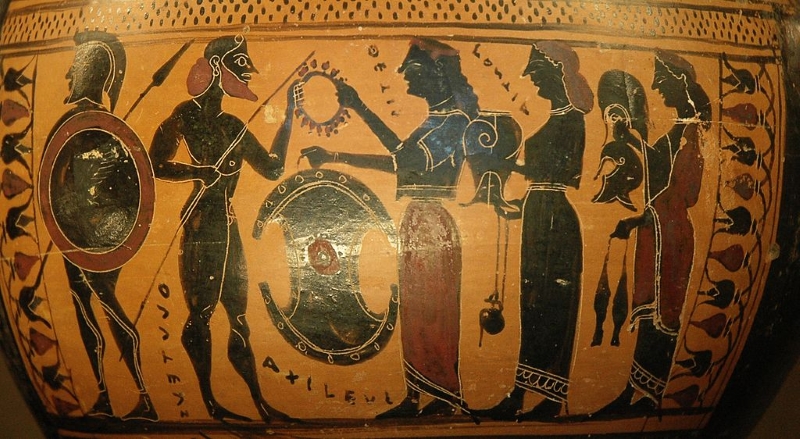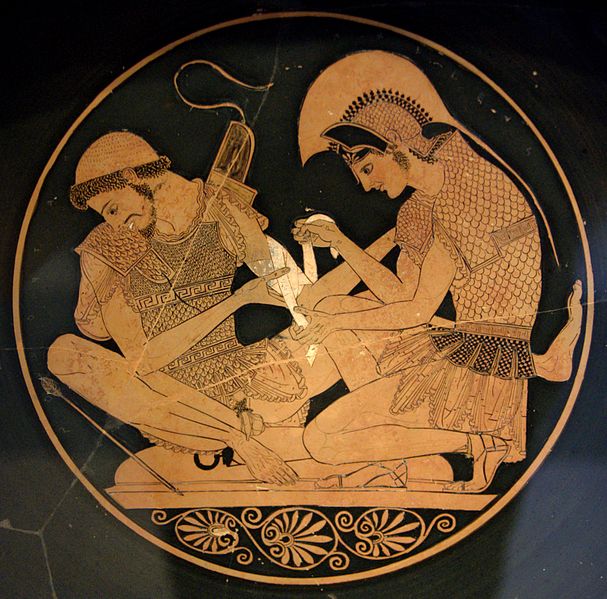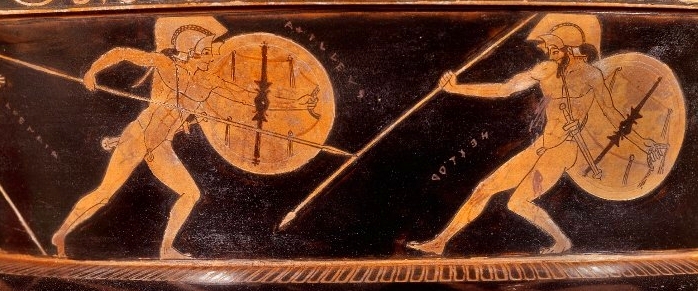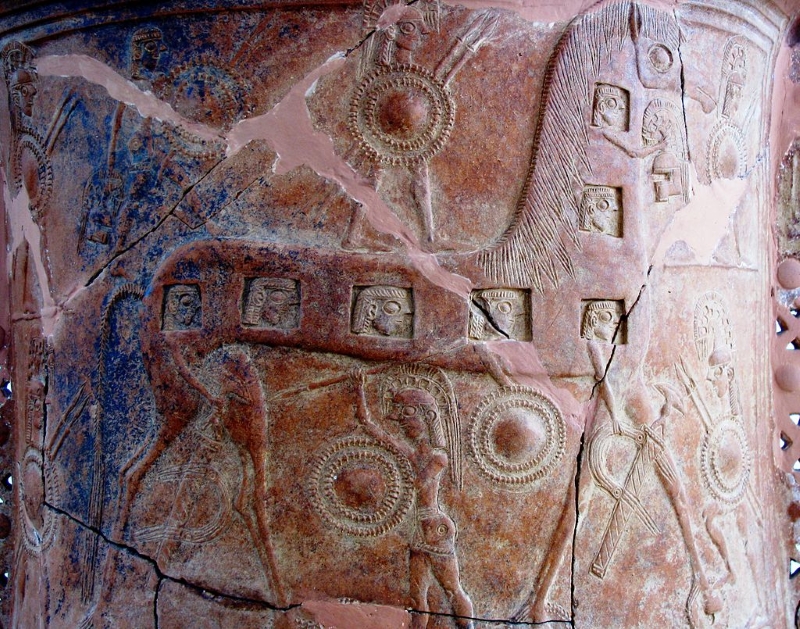|
For centuries, the tale of this single event – the war between the Greeks and the Trojans – served as a social-religious explanation of life, its purpose, its powers, and its limitations.
The "judgment of Paris."
The war supposedly began as a result of a beauty contest among the
goddesses Hera, Athena and Aphrodite ... with the unfortunate Prince
Paris of Troy as the judge. The other two goddesses were burned
when he awarded Aphrodite title as the most beautiful goddess ... and
Aphrodite "rewarded" Paris by having the exceedingly beautiful Helen,
wife of Spartan King Menelaus, fall in love with Paris.
The Achaean alliance.
When both Paris and Helen fled for Troy, King Agamemnon of Mycenae (and
brother of Menelaus) organized a huge Achaean Greek army and navy (some
100,000 men and over a thousand ships) and headed to Troy to try to get
Helen back.
Leading
soldiers of the Achaean army were Achilles – the greatest of all Greek
warriors – and Odysseus the adventurer ... and on the Trojan side,
Hector, son of the Trojan king and kindly hero but also a very
courageous and capable military leader.
The intervention of the gods.
But in any case it would be more than human dynamics that would
determine the outcome ... for the Olympian gods themselves became very
involved in the events, some supporting the Achaeans, others the
Trojans. Deception was often the tool used by the gods to confuse
matters.
The
walls of Troy were insurmountable (thanks to the help of the gods) and
despite the very bloody action between the two sides (often one-on-one
battles among the heroes) years went by with the Achaeans unable to
breach those walls ... although Achaean warriors, such as Ajax, laid
waste to the territories surrounding Troy.
Achilles kills Hector.
Years of failure began to break down Achaean morale ... and Achilles
abandoned the effort when he and Agamemnon fell into a dispute over a
concubine. The Trojans and Achaeans then finally met in open
field for battle which raged back and forth (thanks in part to the
intervention of the gods). Achilles returned to battle when his
friend Patroclus was killed by Hector ... and took on Hector directly
and killed him (dragging Hector’s dead body behind his chariot as he
circled the walls of Troy). Then the story as narrated in the
Iliad ended with Hector’s funeral.
The Achilles heel.
Other legends then take up the narrative from there. One stated
that Achilles was killed by an arrow shot by Paris, who struck
Achilles’s heel ... the only part of Achilles not protected by his
mother’s holding him there in order to dip him into the River Styx for
his eternal protection.
The Trojan horse.
The famous ending to the Trojan War (in its tenth year) was the story
told by the later Roman writer Virgil in his epic poem, the Aeneid,
(also mentioned in Homer’s Odyssey) about the wooden horse that was
left behind in front of the walls of Troy as the Achaeans finally
‘departed’ (though only just out of sight) ... which the Trojans took
as a sign of Achaean acknowledgment of Troy’s ultimate victory.
The Trojans foolishly rolled the horse inside the gates of Troy ...
despite the warning of the Trojan priest Laocoön to “beware of Greeks
bearing gifts”! Indeed, that night, as the Trojans fell into a
wildly drunken stupor, Achaean soldiers hidden inside slipped out of
the horse and opened the Trojan gates, allowing returning Achaean
troops to enter Troy to slaughter, rape, pillage and burn the city ...
to the ground.

Thetis gives her son Achilles weapons forged by Hephaestus
Paris, Louvre Museum

Achilles treating Patroclus wounded by an arrow
Berlin, Altes Museum

Hector fighting Achilles
British Museum

The earliest-known depiction of the Trojan Horse – from the Mykonos vase (c. 670 BC)
Archeological Museum of Mykonos
HOMER AND THIS HIGHER ORDER |
|
 Homer was
an ancient bard (late 800s
or early 700s BC?) whose epic poems, the Iliad and the Odyssey,
gave tighter definition to this divine order. Homer portrayed
a cosmos of rather fickle and often cruel gods who, from Mount Olympus,
called the shots on earth. It was often a wild and crazy affair.
Yet some small sense of equity or justice prevailed to force the gods to
behave (somewhat). Homer was
an ancient bard (late 800s
or early 700s BC?) whose epic poems, the Iliad and the Odyssey,
gave tighter definition to this divine order. Homer portrayed
a cosmos of rather fickle and often cruel gods who, from Mount Olympus,
called the shots on earth. It was often a wild and crazy affair.
Yet some small sense of equity or justice prevailed to force the gods to
behave (somewhat).
In Homer's
saga, the Iliad,
the gods have taken sides in this war between the Greeks and the Trojans.
They serve as protectors over some of the key human players in the drama – most
notably Hector and Achilles.
But their
powers are limited – not
just by Zeus' dominion, but by forces which even Zeus cannot control.
The Greek heros can be protected by the gods – but their ultimate fate,
and the timing of such fate, not even the gods can set aside. Zeus
can hold the scale by which the length of the life of the hero Achilles
is measured – but Zeus himself cannot influence the outcome.
‘Fate’
has a higher power than even the Olympian gods.
Thus
it was that by the time of Homer the ultimate or cosmological Order was
beginning to be understood as somehow transcending the world of the
humanlike Olympian gods. Such Order is a mystery
– yet it is quite real.
Also, we see in Homer's work a very strong moral as well a religious or cosmological message. It seems that the sagas
of Homer were designed to touch the hearts of the aristocratic, more military
minded of the Greeks. Very likely this was some carryover from the
religions brought into Greece by the Greek (Aryan) invaders – offering
religious encouragement and moral justification for their dominant political
roles. The moral theme underlying these sagas was (not surprisingly)
that of valor – valor of the lone conquering hero in the face of overwhelming
odds and even death.a name="Hesiod"> |
HESIOD AND AN ORDERED PANTHEON
(flourised mid-500s BC) |
|
Anaximenes (anak-SI-muneez) was reportedly
a pupil of Anaximander's and the third in the trio of great Milesian philosophers.
He rejected most of Anaximander's theories about the world and the surrounding
universe. He felt that it was self-evident that the world was a flat
object, not a cylinder, and he rejected the idea of the earth just hanging
in a void of space. Like Thales, Anaximenes looked to a less mysterious
source of all things, to a primary material substance foundational to all
things, one more readily present in our observable world.
Anaximenes
concluded that the primal
substance of life was air or mist (pneuma) – an invisible
substance that filled all the universe. It could be both the source
of all things, and yet one of the created things itself – because of its
power to change form. Here too, it was probably natural for Anaximenes
to accord air the honor of being the primal substance or underlying material
of all things. Greeks commonly understood air to be the ‘breath’
or ‘spirit’ (also pneuma) of life, the source of the soul, and so
it was logical to think that air might be the primal substance of all things,
the soul or spirit of all life.
In any case,
he argued that through
a process of becoming more or less dense, air could change form.
Thus fire was air in its most rarified form. The natural progress
from there as air thickened was: wind, clouds, water, earth, and
stone. Also, the soul quality of air (as the Greeks understood it)
could explain movement, events, life itself.
All in all, Anaximines' theory of
the substance of life seems more complete than his Milesian predecessors.
It was truly a great intellectual accomplishment – though being founded
on a faulty premise, we find it interesting only for its methodology and
not for its conclusions.
|
|
Side by side
with the Olympian pantheon
existed a number of religious ideas and practices of the Greeks.
Some of it came in with the Doric invaders of the 1100s BC and some of
it either predated all Aryan Greek invasions – or else came in later from
the East. These tended not to be so orderly but instead seemed to
anticipate the disorder of life caused by gods who needed to be appeased
directly (through sacrifices) and often.
Among the
Greeks one of the most
persistent and widely popular of such non-Olympian religions was Dionysianism.
This was a rather wild fertility cult that perhaps predated the Greeks
– a cult which managed to get a quite a hold on the Greeks at some point
in their history.
The Thracian story of Dionysus/Bacchus
seems to have developed many versions over the centuries--especially as
the story was assimilated into Greek theology. It may have originally included blood sacrifice
– perhaps even human as well as animal. Indeed part of the original
Dionysian myth brings the hero Dionysus to a bizarre death at the hands
of female devotees, who literally tore him limb from limb in a religious
frenzy.
One of the major versions
tells us that Dionysus/Bacchus (called also Zagreus) was the "illegitimate"
son of the god Zeus and the goddess Persephone. He was torn to pieces and
eaten as a boy by the Titans--set up in their fury by a jealous Hera, the
wife of Zeus. The Titans then themselves took on divinity from such a grisly
meal. But in turn, the Titans were struck by lightning--and turned to ashes.
But from the ashes of the
Titans grew the human race: which is thus part divine (Zagreus) and part
evil (the Titans)!
But also: Bacchus' heart was
not eaten but given to Zeus, who used it to bring Bacchus back to life.
Some versions of the story tell that this happened as Zeus swallowed the
heart himself. Other versions tell that this happened when the heart
was given to Semele--who swallowed it and gave birth to Dionysus.
Another version of the story
tells us that Dionysus was reputedly the son of Zeus and Semele (Phrygian
goddess of the "earth" or "Earth Mother"). By mysterious circumstances,
Semele was destroyed by Zeus' power of lightning--along with the boy.
But Zeus rescued the boy from the ashes, taking him up and encasing him
in his thigh--from which he was reborn later in his maturity.
According to most accounts,
Dionysus traveled the world to teach the cultivation of grapes (and to
spread his worship among men).
According to several different
accounts, Dionysus was killed by either a group of crazed women--or by
his own his own mother--in a frenzy of the very worship which he introduced
to the people.
Thus the tearing and eating
of raw flesh of a sacrificial animal (symbol of Bacchus) was understood
to impart divinity to the devotee--as it did the Titans.
Being a
fertility cult, it was a
rite closely associated with the growing season – especially of the grape,
the source of the Greek's precious wine. Drunkenness was thus a natural
accompaniment to the festivities.
It seems however that gradually this
worship form was toned down by the Greeks – until it became a respectable
worship form involving even the Greek aristocracy (who were always the
bastions of original Olympian worship). Indeed, it was the
refinement of Dionysianism that produced Greek drama – for it was at the
Dionysian festivals that the famous Greek playwrights (Sophocles, Euripides,
Aristophanes, etc.) offered their new theatrical pieces to their Greek
audiences.
|
|
Orphism seems to
have been part of
that effort to tame Dionysianism. But even this later development
within Dionysianism is so clouded with mythology that it is hard to tell
how or where it all started. The figure of Orpheus stands at the
heart of this Dionysian "movement." There may have actually been
a religious reformer who gave rise to the Orphic myth. But by and
large, the Orpheus that has come down to us in story or myth seems to belong
to the world of the gods rather than men.
The common story was that he was the
son of the Thracian king Oeagrus (or some Thracian god) and a Muse.
From his mother's side he inherited great musical talents. From his
father's side he inherited his love of adventure.
As an adventurer, he took part in
the Argonaut expedition of Jason--where he played a key role with his music
making.
Later stories have him as a wandering
philosopher in search of knowledge.
He married Eurydice, who was bitten
by a serpent and died. Being inconsolable over this loss, Orpheus
went down to Hades to get her back. He wooed her from the gods with
his beautiful music--who let her go. But they did so on the promise
that she would not look back on her way out of Hades. But she failed
in this important stipulation--and was returned to Hades as a ghost.
As a result, Orpheus vowed to have
nothing more to do with women. But the Thracian women (or frenzied Maenads?),
during a Dionysian orgy, tore him apart--the same fate that met Dionysus.
(Beware of Thracian women!)
Ultimately Orphism developed into a
theological refinement of the Bacchic religion. At first it was strongly
persecuted by Bacchic priests. But eventually it became established
within the Bacchic system.
Orphic teachings that began to come
forth over time had much in common with Hinduism and Buddhism (perhaps
from mutual Aryan roots). Orphism held a sense of dualism about human
existence: 1) the earthly or physical existence (derived from the Titans)
and 2) the heavenly or spiritual existence (derived from Zagreus or Bacchus
or Dionysius).
Within Orphism, earthly life was
seen only as a merciless round of pain and trouble (product of evil).
Though we humans belong to the heavens, to the stars (as semi-gods), we
are also bound to life by a cycle of death and rebirth. The goal
of life: escape from earthly existence and release to eternal life.
But the fate for most folks was really
not escape--but rather a period of death (and torment) and then rebirth--according
to the merit of one's earthly deeds.
Thus Orphism held much concern about
the after-life. It included instructions on how to enter the after-world.
Likewise, it sought to reform Bacchic or Dionysian worship in order to
increase one's spiritual nature--and diminish the portion of one's physical
being so as to become one with Bacchus (or Dionysus).
Orphism
shared many features in common
with another worship form found further to the East: Hinduism.
Orphism developed a theology of reincarnation and transmigration of the
souls through endless cycles of birth, growth, decay and death – in which
escape from the grip of this eternal dance was the desired goal of the
Orphic devotee (as with Hinduism's offshoot, Buddhism)
Orphism, as a worship or religious
form also had various kinds of purity rituals designed to help the devotee
avoid certain types of contaminating influences. Thus the most rigorous
practitioner avoided animal food (as with the Hindus) except for sacrificial
rituals. Further, despite its connection with wild Dionysianism,
the Orphic devotee took wine only as a sacramental act--as a symbol indicative
of the mystical enthusiasm of one who sought union with the god Bacchus--or
Eros!
Orphism
shared many features in common
with another worship form found further to the East: Hinduism.
Orphism developed a theology of reincarnation and transmigration of the
souls through endless cycles of birth, growth, decay and death – in which
escape from the grip of this eternal dance was the desired goal of the
Orphic devotee (as with Hinduism's offshoot, Buddhism)
|
Return to the section: Early Philosophical Development
 Miles
H. Hodges Miles
H. Hodges
|


 The fabled Trojan War
The fabled Trojan War
 Hesiod and an ordered pantheon
Hesiod and an ordered pantheon






 Homer was
an ancient bard (late 800s
or early 700s BC?) whose epic poems, the Iliad and the Odyssey,
gave tighter definition to this divine order. Homer portrayed
a cosmos of rather fickle and often cruel gods who, from Mount Olympus,
called the shots on earth. It was often a wild and crazy affair.
Yet some small sense of equity or justice prevailed to force the gods to
behave (somewhat).
Homer was
an ancient bard (late 800s
or early 700s BC?) whose epic poems, the Iliad and the Odyssey,
gave tighter definition to this divine order. Homer portrayed
a cosmos of rather fickle and often cruel gods who, from Mount Olympus,
called the shots on earth. It was often a wild and crazy affair.
Yet some small sense of equity or justice prevailed to force the gods to
behave (somewhat).
